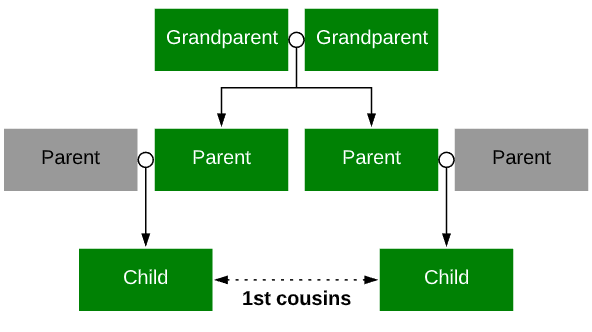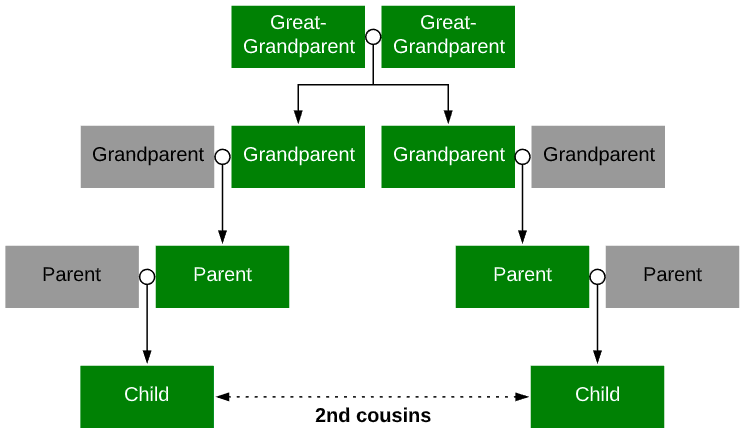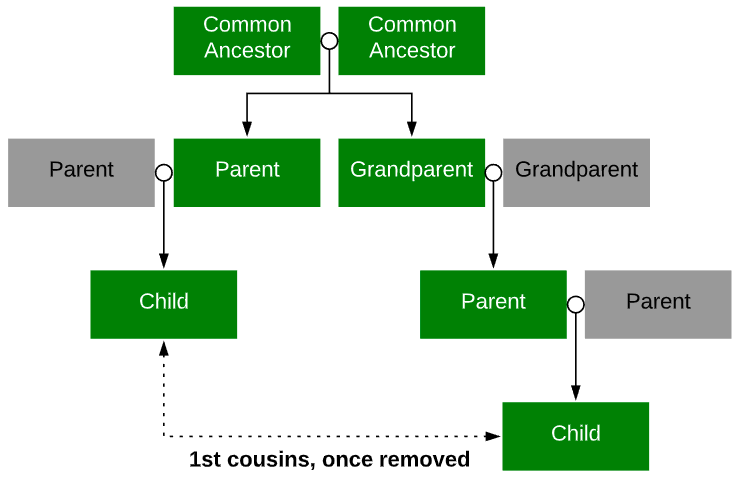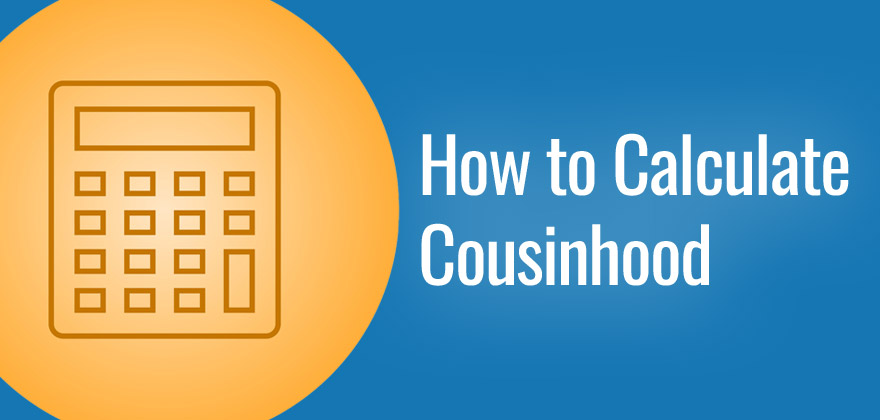Everyone has a cousin, or two, or dozens! It’s easy to understand how we are related to our first cousins- they are the children of our aunts and uncles and we share a common set of grandparents. But when it comes to more distant cousin relationships, those family ties can become quite confusing.
How do you calculate cousins?
This article will teach you how to calculate cousins. Be sure to also check out our handy cousin calculator tool which shows you a visual representation of how two cousins are related.
Ok, now it’s time to learn how we’re connected to all of those distant cousins on our family tree!
First, let’s look at cousin relationships within the same generation.
Same Generation
You know that the children of your aunts and uncles are your first cousins and that together you share the same grandparents on either your father’s or mother’s side of your family tree.
First cousins are in the same generation- if viewed in your family tree, these cousins will sit along the same row of the tree as you and your siblings.
Second cousins share the same great-grandparents:
- Their grandparents are siblings,
- And their parents are first cousins.
Second cousins will also sit in the same generational row as you, your siblings, and your first cousins- their branch will just be a little further away.
This pattern continues as you move into third, fourth and so on, cousin relationships.
Third cousins share the same 2nd great-grandparents:
- Their great-grandparents are siblings,
- Their grandparents are first cousins,
- And their parents are second cousins.
The relationships just keep moving back a generation, and the rows of cousins in the family tree move a little further away.
Related: What is a Third Cousin
The ISOGG (International Society of Genetic Genealogy) Wiki page provides a great cousin relationship reference chart, as shown below.ISOGG cousin chart. click to enlarge
You can see that the cousin relationships between 1st, 2nd, 3rd cousins, and so on, are defined by sharing a set of ancestral grandparents in the same generation, as color-coded on the chart. Your fourth cousin’s 3rd great-grandparents are your 3rd great-grandparents too.
You can also find plenty of other helpful cousin-explaining charts by doing a quick search online!
Different Generation (“Removed”)
Of course, your parents, grandparents, great-grandparents and so on, have cousins within their own generational rows too. That’s where the removed definition comes in.
“Removed” simply indicates that this cousin relationship is separated by a certain number of generations.
Here are some examples:
- Your parents’ first cousins are your first cousins once removed. They are in your parents’ generation, which is one generation away from you.
- Your grandparents’ first cousins are your first cousins twice removed. They are in your grandparents’ generation, which is two generations away from you.
- Your great-grandparents’ first cousins are your first cousins 3x removed, and so on.
The removed relationship works both up and down the family tree.
- Your first cousins are your children’s first cousins once removed
- Your first cousins are your grandchildren’s first cousins twice removed.
- Additionally, your cousin’s children are your first cousins once removed, and your cousin’s grandchildren are your first cousins twice removed.
Adding an additional layer of complexity, the more distant cousin relationships can also be removed.
- Your great-grandparent’s second cousins are your second cousins 3x removed, as you are three generations away from those second cousins
- Your second cousins are also your great-grandchildren’s second cousins 3x removed, as they are three generations away from those second cousins.
More distant cousin relationships can quickly become confusing- and even professional genealogists sometimes have trouble calculating cousin relationships. Luckily, there are some handy tips that can help you figure out just how far away those cousins are!
Calculating Cousin Relationships
Cousin charts can sometimes limit your understanding of cousin relationships if you rely on them too heavily. Additionally, you may not have a chart handy all the time- for example, when visiting a cemetery to identify ancestor cousins’ gravestones. Therefore, learning other methods to calculate cousin relationships can be of great benefit to the family historian.
Here are some basic steps to identifying a cousin relationship – without a chart!
For cousins that are in the same generation:
- Determine the most recent common ancestor between the two people whose relationship you are trying to determine. This may be a shared ancestor between you and a distant cousin, or perhaps between two other cousins.
- For great-grandparent relationships, you can simply “add 1” to the grandparent relationship, to determine the cousin relationship. For example, if you determine that both you and your mystery cousin share the same set of 2nd great-grandparents, that makes you 3rd cousins. If you share 4th great-grandparents, that means you are 5th cousins.
- If both of the cousins are in the same generation, then you will not need to calculate a “removed” relationship. Note that just because there’s a big age difference between you and your cousin does not mean you’re from a different generation.
For cousins that are NOT in the same generation:
- Follow the steps above for the person who is more closely related to the common ancestor. Let’s say only one of the cousins can trace these ancestors back as their 4th great-grandparents. You would assign this person a 5th cousin designation, as shown in the “add 1” example above.
- Next, determine the number of generations between the two potential cousins. Or conversely, determine how many generations further away from the common ancestor the second person is. If the second person is two generations further away from that shared ancestor (or, there are two generations separating the first and second person), then these two people would be 5th cousins twice removed.
Family History Daily provides some great examples to help you understand “cousin math.” With practice, you can become adept at calculating your cousin relationships without relying on a chart.
Cousins and Their Shared DNA
There are two main points to remember when trying to determine a cousin relationship through DNA results.
The probability that two cousins will share enough DNA to be detected via testing
As shared ancestors move further back in time, the likelihood that two cousins will share part of that ancestor’s DNA will decrease. The ISOGG Wiki has a helpful chart that compares the probability of cousin relationship matching provided by three of the major testing companies.
For example, 23andMe, AncestryDNA and Family Tree DNA all guarantee a 100% probability that your DNA will match with any first cousins in their respective databases.
Once you move back to fourth cousin relationships however, 23andMe and Family Tree DNA have about a 50% likelihood that you will match with any fourth cousins in their databases, while Ancestry provides a 71% probability.
By the time you get to seventh cousins, Family Tree DNA has a 0% probability of a match, while the others can only provide a 3% or less likelihood.
The probability chart provides a clear example of how the amount of shared DNA between cousins grows smaller, the farther away you descend from that shared ancestor.
The amount of shared DNA between different cousin relationships
Most of the major DNA testing sites will provide a relationship estimate for your matches- but more importantly, they will also provide the amount of centimorgans shared between you and your matches.
Centimorgans (cM) are a unit of frequency used to measure genetic distance between two people- usually, cM are used to measure the length of DNA shared on an individual chromosome (ISOGG).
For example, you may share 57 cM of DNA on chromosome 8 with one particular cousin, and 119 cM of DNA on chromosome 14 with another.
The total centimorgans shared between two people can actually provide a more accurate relationship estimate than the one provided by the testing company!
One of the most helpful (and free!) cM estimator tools online is the DNA Painter Shared cM Project, a collaboration by Johnny Perl, and well-known genetic genealogists Blaine Bettinger and Leah Larkin.
Not only does this site provide a helpful shared cM chart for understanding how much DNA is typically shared within various family relationships, it also has a handy cM calculator that will convert your shared cM to a percentage of DNA shared.
The calculator will also provide a list of relationship estimates based on the amount or percentage you enter.
If, for example, Ancestry reports that you have a “3rd-4th Cousin” match that shares 154 cM total of DNA with you, you can enter “154” into the Shared cM Project calculator to get a more specific relationship estimate.
You’ll see that this person could actually have one of several relationships with you, including half second cousin, second cousin once removed, or a first cousin 3x removed.
There is also a lesser probability that this person may have a completely different relationship with you, including half 2nd great-aunt or uncle (if you have any that may still be alive!).
This terrific tool helps you narrow down the possibilities to help inform your family tree research.
Other Things to Consider
You may sometimes come across “half-cousins”- cousins with whom you only share one grandparent. This generally means that your parent and your aunt or uncle are half-siblings who share just one parent- therefore, that aunt/uncle’s children are your half-first cousins.
There are also “double-cousins,” where two siblings of one family marry and have children with two siblings from another family. Their children are related to each other through both of their parents, and are considered double related.
Double first cousins will usually share more DNA with each other than first cousins that are only related through one parent. Double cousins were often common in smaller, rural communities, where families knew each other and had large families of children who were the same ages.
It was not considered unusual for cousins to marry, although first-cousin marriage has declined in Western countries since the 19th century.
Cousin marriage was often practiced to “keep cultural values intact, preserve family wealth, maintain geographic proximity…maintain family structure or a closer relationship between the wife and her in-laws.”
Did you know that the global population of Ashkenazi Jews, a Jewish community descended from Central and Eastern Europe, are all related?
A scientific study in 2014 determined that the entire Ashkenazi population descended from the same 350 or so people, which means that all those who have Ashkenazi heritage today are 30th – 32nd cousins!
Figuring out distant cousin relationships can seem scary at first, but understanding how these relationships work, and the shared DNA behind them, can take the “fright” out of your genealogy research!
And as you can see, there’s a lot of interesting history hidden in those distant branches of the family tree!
Read more articles about kinship.



Curious on finding out by accident that youre spouse and you are 13 th cousins from a grandmother that had 4 kids in 19oo